
Kiosks & Digital Signage - no longer a ‚Waiting-of-Godot-Market’
Within recent months a lot of studies and whitepapers on the deployment of Kiosk- / Self-Service-Terminals has been published - see also the list under http://www.ercm.de/kiosk-studien.html . Here now a short overview about the results of some actual studies and analyses.
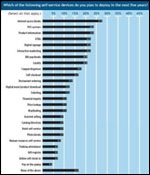 The „Self Service World 2006 Market Survey" showed that Internet access, product information , interactive marketing, digital signage and couponing are the most commonly deployed solutions within the next weeks and months. Surpringly Human Resources (HR) applications did
The „Self Service World 2006 Market Survey" showed that Internet access, product information , interactive marketing, digital signage and couponing are the most commonly deployed solutions within the next weeks and months. Surpringly Human Resources (HR) applications did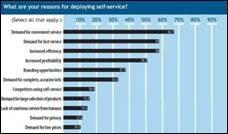 not get that attention in the survey, that they been forecasted in other market studies. Within the next 5 years Digital Signage, Self-Check-out as well as Music-/Product-Downloads will additionally grow. As reasons for the deployment of kiosk terminals mainly 67 percent said customer demand for convenient service was driving their self-service initiative followed by customer demand for fast service, the desire for increased operational efficieny (each 58 percent), a greater profitability (51 percent) as well as enhanced branding opportunities (38 percent). Within the next 12 months about 80 percent of the companies will increase their spendings on self-services and even 91 percent would increase in the next 3 years. Amazing is also the realization that only a mere 35 percent researched by themselves or through a research firm whether these investments was accepted by the customers and what at all their customers want.
not get that attention in the survey, that they been forecasted in other market studies. Within the next 5 years Digital Signage, Self-Check-out as well as Music-/Product-Downloads will additionally grow. As reasons for the deployment of kiosk terminals mainly 67 percent said customer demand for convenient service was driving their self-service initiative followed by customer demand for fast service, the desire for increased operational efficieny (each 58 percent), a greater profitability (51 percent) as well as enhanced branding opportunities (38 percent). Within the next 12 months about 80 percent of the companies will increase their spendings on self-services and even 91 percent would increase in the next 3 years. Amazing is also the realization that only a mere 35 percent researched by themselves or through a research firm whether these investments was accepted by the customers and what at all their customers want.
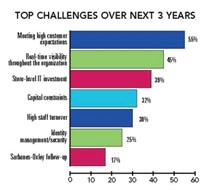 Gartner examined in the "16th Annual Retail Technology Study: Committing to the Customer" the challenges of retailers. The main top challenges are with 55 percent meeting high customer expectations and with 45 percent the real-time visibility throughout the organization. Store-level IT investments rank in third place - in the last year still at place 1. POS upgrades have been a major focus in the last few years, but as retailers begin to complete these projects or get sufficiently down the path toward completion, POS begins to move lower on the priority list. Investments now flow especially in such technologies designed to improve the customer experence, as for example mobile devices, kiosk terminals, business intelligence tools and RFID. On store level, beside kiosk terminals especially large screen displays / digital signage and self-check-out ar
Gartner examined in the "16th Annual Retail Technology Study: Committing to the Customer" the challenges of retailers. The main top challenges are with 55 percent meeting high customer expectations and with 45 percent the real-time visibility throughout the organization. Store-level IT investments rank in third place - in the last year still at place 1. POS upgrades have been a major focus in the last few years, but as retailers begin to complete these projects or get sufficiently down the path toward completion, POS begins to move lower on the priority list. Investments now flow especially in such technologies designed to improve the customer experence, as for example mobile devices, kiosk terminals, business intelligence tools and RFID. On store level, beside kiosk terminals especially large screen displays / digital signage and self-check-out ar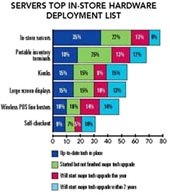 e on the top in-store hardware deployment list. 30 percent of respondents have alrady deployed digital signage solutions or have started to deploy. This figure should be in opinion of Gartner quite greater, considers one that one sees such displays meanwhile everywhere in retail . A similar „adoption rate" was also posted for kiosk terminals - but the reason kiosks don't record higher adoption numbers ist hat not all retail formats find equal value in that technology. More formats may ultimately find kiosks a useful tool for either customer-facing or staff-related functions, but currently there doesn't appear to be a compelling reason to produce a spike in the slow-but-steady rollout that has been going on for more than a decade. And referring self-check-out Gartner said, that to many retailers it adds nothing to the superior-quality in-store expereince these retailers are trying to achieve.
e on the top in-store hardware deployment list. 30 percent of respondents have alrady deployed digital signage solutions or have started to deploy. This figure should be in opinion of Gartner quite greater, considers one that one sees such displays meanwhile everywhere in retail . A similar „adoption rate" was also posted for kiosk terminals - but the reason kiosks don't record higher adoption numbers ist hat not all retail formats find equal value in that technology. More formats may ultimately find kiosks a useful tool for either customer-facing or staff-related functions, but currently there doesn't appear to be a compelling reason to produce a spike in the slow-but-steady rollout that has been going on for more than a decade. And referring self-check-out Gartner said, that to many retailers it adds nothing to the superior-quality in-store expereince these retailers are trying to achieve.
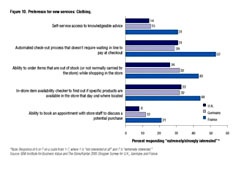 The study „Driving successful occasions through deeper insights" from IBM Institute for Business Value in collaboration with The Store/Kandar and the National Retail Federation (NRF) reports about the results of a survey at more than 5.000 customers in Germany, UK and France. It has analyzed the shopping experiences in groceries, clothing stores and consumer electronic markets. German and British consumers focus only, or mainly, at 86 percent resp. 91 percent on buying in one grocery shop when they undertake a shopping trip, compared with just 61 percent of French consumers. Conversely, customers who want to buy clothes or consumer electronics are less likely to focus, or largely, (between 53 and 66 percent) on a specific store and product group when they are shopping. Very often the urpose for which they are shopping changes during the course of the trip, beeing influenced by amyriad of things like assortment and placement of merchandise and spezial promotions. Retailers that have understood what persuades shoppers to put also other things in their baskets have re-designed their stores to capture such impulse buying. Mood makes a bigg diiference in how much shoppers spend. Only 44 percent of German shoppers who were shopping for groceries enjoyed the experience, compared with 55 percent of those who were shopping for consumer electronics and 59 percent of those who were shopping for clothes. About 20 percent of British grocery shoppers say that the shoppingis boring, compared with 51 percent of French shoppers who described the trip as enjoyable / relaxing. In all three countries consumers who thought shopping was exciting spent more than three times as much as those who thought it was boring. This shows how important it is to stimulate the interest of shoppers who are "just looking", "browsing" in order to positively influence, to emotionalize them during their shopping trip to stay longer in the store and therefore to spend more. Shopping for clothes customers want to check the availability of specific products, but also to be able to order out-of-stock items in other stores or via the store's Web site, at the self-service checkout or self-service kiosk terminals. Kiosk terminals are important tools to help customers search for products or match the features they want with the products or even to try a product before they buy. And displays / digital signage help to conduct tthe interest of shoppers who are "just looking" on novelties and to encourage them to convert from browsing to buying. Very important is it to identify why consumers walk through the store and whether the new technologies will indeed add the expected value to them - the most successful technologies will generally be those that are transparent to customers.
The study „Driving successful occasions through deeper insights" from IBM Institute for Business Value in collaboration with The Store/Kandar and the National Retail Federation (NRF) reports about the results of a survey at more than 5.000 customers in Germany, UK and France. It has analyzed the shopping experiences in groceries, clothing stores and consumer electronic markets. German and British consumers focus only, or mainly, at 86 percent resp. 91 percent on buying in one grocery shop when they undertake a shopping trip, compared with just 61 percent of French consumers. Conversely, customers who want to buy clothes or consumer electronics are less likely to focus, or largely, (between 53 and 66 percent) on a specific store and product group when they are shopping. Very often the urpose for which they are shopping changes during the course of the trip, beeing influenced by amyriad of things like assortment and placement of merchandise and spezial promotions. Retailers that have understood what persuades shoppers to put also other things in their baskets have re-designed their stores to capture such impulse buying. Mood makes a bigg diiference in how much shoppers spend. Only 44 percent of German shoppers who were shopping for groceries enjoyed the experience, compared with 55 percent of those who were shopping for consumer electronics and 59 percent of those who were shopping for clothes. About 20 percent of British grocery shoppers say that the shoppingis boring, compared with 51 percent of French shoppers who described the trip as enjoyable / relaxing. In all three countries consumers who thought shopping was exciting spent more than three times as much as those who thought it was boring. This shows how important it is to stimulate the interest of shoppers who are "just looking", "browsing" in order to positively influence, to emotionalize them during their shopping trip to stay longer in the store and therefore to spend more. Shopping for clothes customers want to check the availability of specific products, but also to be able to order out-of-stock items in other stores or via the store's Web site, at the self-service checkout or self-service kiosk terminals. Kiosk terminals are important tools to help customers search for products or match the features they want with the products or even to try a product before they buy. And displays / digital signage help to conduct tthe interest of shoppers who are "just looking" on novelties and to encourage them to convert from browsing to buying. Very important is it to identify why consumers walk through the store and whether the new technologies will indeed add the expected value to them - the most successful technologies will generally be those that are transparent to customers.
Due to Capgemini's report „Wave of Innovations in Retail - re-explore Information Management" technol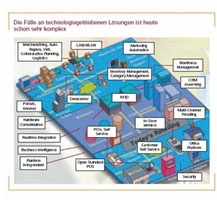 ogy has indeed the potential to positively influence the customer shopping experience: product finder discharge customers searching for products and kiosk systems can also order out-of-stock products. The employees' discharge via technology gives room for more advise and services to the customers. The technology advantagelies here less in cost savings, but rather in generating additional turnover potentials by further consultation. And digital signage in the near furture will lasting change face of in-store marketing. Product introductions, the explanation of applications and the contemporaneous switching of in-store advertisement open unexpected perspectives which let become the age of the „pasteboard at the cover" past. Rather target group related video spots which will be presented on several displays in the store are real examples in retailing - as well as electronic advertising pillars and kiosk terminals. By this there is built up a quite more intensive dialogue at the point of sale then than the classical communication could ever provide. To built up a competitive advantage with technologies presumes however that such an intenttion has to be planned in a structured way.
ogy has indeed the potential to positively influence the customer shopping experience: product finder discharge customers searching for products and kiosk systems can also order out-of-stock products. The employees' discharge via technology gives room for more advise and services to the customers. The technology advantagelies here less in cost savings, but rather in generating additional turnover potentials by further consultation. And digital signage in the near furture will lasting change face of in-store marketing. Product introductions, the explanation of applications and the contemporaneous switching of in-store advertisement open unexpected perspectives which let become the age of the „pasteboard at the cover" past. Rather target group related video spots which will be presented on several displays in the store are real examples in retailing - as well as electronic advertising pillars and kiosk terminals. By this there is built up a quite more intensive dialogue at the point of sale then than the classical communication could ever provide. To built up a competitive advantage with technologies presumes however that such an intenttion has to be planned in a structured way.
Due to a survey of the advertising agency „Die Gefährten" from Cologne marketing decision-makers have already intensively deployed POS activities and have increased their marketing activities at the POS for example in the second half-year 2005 by 35 percent. With local promotions the companies wanted to set off particularily from their competitors. This works best with multimedia elements. Most companies therefore intend to deploy displays which are to provide for more attention. With sich innovative tools "Die Gefährten" could increase their customers' revenues up to 68 percent.
Also Display & Design Ideas' (DDI) „2005 Industry Survey ‚In-Store Technology'" showed that in-store budgets increase and are mainly used for video walls (58,1 percent), digital signage (49,1 percent) and kiosk terminals (48,9 percent). The satisfaction with these technologies ranks between 20 to 49 percent and is based on their experiences over the past three years. As No. 1 Top In-Store Trend respondents voted interactive kiosk terminals, „they will be used mainly as a marketing tool and to increase brand awareness". The No. 2 Top In-Store Trend is Digital Signage.
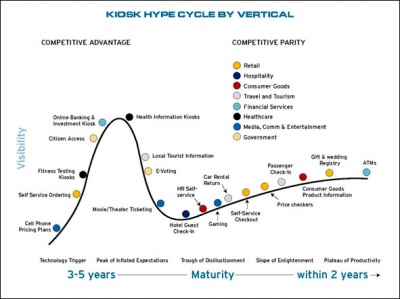 The Oracle Retail Global Business Unit hat has analyzed in their study „Holiday Season 2006: What's In Store" the role of technology in improving operational efficiency and the customer experience. They found that point-of-sale systems top with 37 percent the retailers' IT wish list, they are only exceeded by inventory management systems with 45 percent.
The Oracle Retail Global Business Unit hat has analyzed in their study „Holiday Season 2006: What's In Store" the role of technology in improving operational efficiency and the customer experience. They found that point-of-sale systems top with 37 percent the retailers' IT wish list, they are only exceeded by inventory management systems with 45 percent.
In the „6th Annual Kiosk Benchmark Study: Step Right up - Kiosks command Attention across Verticals" , researched by Gartner and published by Kiosk Business, there is reported about increased user acceptance as well as growing budget and deployment sizes of kiosk resp. self-service installations. 62 percent of respondents indicated kiosks as vital or even very beneficial for their business. The average deployment size isr still small, about 36 percent have installed 1 to 10 terminals and 16 percent 11 to 50 terminals - but have grown year by year. 42 percent expect a ROI already within the first year and 23 percent said that their goal is branding not profit. Gartner resumes that after several years of risk with little return kiosks now have crossed the Rubicon, e.g. reached a point where they are becoming an inevitable part of every retailer's multichannel and customer-centric strategies. . But also in the hospitality segment kiosk technology adaoption has moved beyond the pilot stage and is now at the "knee of the curve". Gartner's yearly Kiosk Hype Cycle Chart shows that a number of applications no longer provide a competitive advantage, but rather ensure competitive parity - for ATMs, gift and wedding registers or check-in-terminals kiosk deployment is a given. For other applications such as online banking & investment kiosks, citizen access and self service ordering kiosks can provide a true advantage in the marketplace.
More information you will find shortly in the „MediaCityReport"- the extensive study about the practical deployment of kiosk and Digital Signage all over the world - as well as permently updated lists of kiosk studies and whitepapers and market figures under http://www.ercm.de/kiosk-studien.html resp. http://www.ercm.de/kiosk-marktzahlen_1.html




